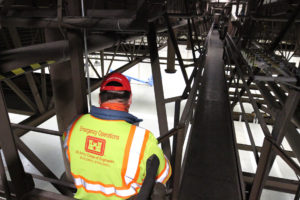
By Marshall Swearingen, MSU News Service
As the first wave of the coronavirus pandemic was rising in the U.S. earlier this spring, Montana State University engineering alumnus John Greenheck was in a good position to help.
After earning his bachelor’s in civil engineering from MSU in 1999, he had spent more than 14 years specializing in hospital design before taking a new job last year as a structural engineer with the Army Corps of Engineers, working on hospitals for the Department of Veterans Affairs. So when the Corps asked for volunteers to help plan emergency facilities to treat COVID-19 patients, Greenheck jumped right in.
“As an engineer who wants to solve problems, I was glad to have a way to help move things forward,” said Greenheck, who lives in Los Angeles. “When I got the call, I grabbed my gear and hit the road.”
For several days in early April, he worked with an Corps team called Task Force Nevada to assess how five major buildings in Las Vegas, Reno and Carson City could be rapidly repurposed to treat patients sickened with the disease. In coordination with the Federal Emergency Management Agency, the team developed design plans — including one for converting the huge Las Vegas Convention Center into a 900-bed facility — that were presented to state officials.
The job meant crawling along ceiling beams to inspect for defects and shuffling around the icy roof of the Reno Sparks Convention Center after a snowstorm, he said. “It felt good to do something positive to help people during a time when there’s not a lot that most people can do” because of the stay-at-home orders, Greenheck said.
Designing a new hospital is a complex task because the structure needs to accommodate specialized ventilation ducts and other infrastructure not found in a typical building, Greenheck noted, and planning for how to repurpose an existing structure raised additional challenges. His ability to work effectively with the team’s electrical, mechanical and sanitation engineers harkened back to MSU, where he said there was a culture of students from different engineering fields working together on homework assignments and capstone projects. While at MSU, he was also heavily involved in the student club that designs and races a canoe made of concrete as part of a national competition each year.
Greenheck said he has also come to value what he calls the “practice-based” approach to engineering education at MSU. “The way we would approach problems in upper-level classes — not just sizing beams and bolts but seeing the big picture and how all the systems fit together — really set a groundwork that has served me well.”
“The COVID-19 crisis has made clear the importance of infrastructure to our society,” said Craig Woolard, head of the Department of Civil Engineering in MSU’s Norm Asbjornson College of Engineering. “We’re proud of John and our other alumni who are out solving problems. It’s a source of pride that our programs prepare our graduates for these important roles.”
Greenheck, who grew up in Denver and was drawn to MSU because of family ties in Montana, described how the COVID-19 situation had brought into focus his view of the engineer’s role in the world. “You can measure your impact by the size of the problem you can solve,” he said. “That’s how I try to look at how I’m living. What problem can I solve? Who can I help?”
If he could go back and give himself advice as an MSU freshman, he would emphasize the importance of the kind of service that brought him to Nevada last month, Greenheck said. “Look for opportunities to help others, to do things that serve something bigger than yourself. You won’t regret it.”